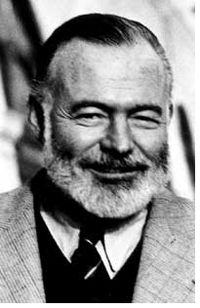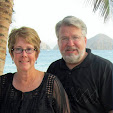Lazy Two-Hearted River
We're on a mini-vacation in the north-west fingertip of Michigan’s mitten. (We're missing our second daughter who is on a missions trip to the U.P. with the youth group.) Monday will be our second and third daughters' birthday—they were both born on June 19th (eight years apart). This will be the first time in eleven years that they have not been together to celebrate. Life's getting more an more like that, which is one of the reasons we took this mini-vacation while our oldest daughter could join us.
 This area of Michigan is great for road trips. Every few miles or so, there's a
This area of Michigan is great for road trips. Every few miles or so, there's a  scenic, post-card lake, nestled in the rolling hills and wreathed in towering white pines that stretch to the sky like masted steeples. The biggest one we saw yesterday was Walloon Lake.
scenic, post-card lake, nestled in the rolling hills and wreathed in towering white pines that stretch to the sky like masted steeples. The biggest one we saw yesterday was Walloon Lake.
These little lake towns thrive in the summer and “hunker down” through the winter (when they host hunters, skiers, and snow-mobilers) This contrast in clientele is evident in all restaurant décor—a blend of “north woods” and nautical: canoe paddles and snow shoes, water skis and snow skis side by side. It all makes sense up here.
Not all of the towns are small. Gaylord, where we spent last night, is pretty big, and to the north or west, there are three great bayside towns along the shoreline: Petoskey, Charlevoix, and Traverse City.
We spent Saturday in Petoskey. We've spent time in nearly all of Michigan's famous shoreline towns from Saugatuck to Mackinac, but we had only passed through Petoskey six years ago. As we drove by the Victorian homes and cottages of the Bayside district, we vowed to return for a better look. They're perfectly maintained "gingerbread" houses situated on a hill overlooking Little Traverse Bay like Julie's ceramic collectibles on our mantle at Christmas.

Little did I know Petoskey held an even more intriguing claim to fame. We decided to have lunch in The Gaslight District downtown and just happened upon a historic place called "The City Park Grill," a favorite eatery in the 1920's of none other than Earnest Hemingway. I knew nothing about it until my astute oldest daughter read the menu aloud to me. (She just asked me to credit her for that.)
I knew that some of Hemingway's stories were set in Michigan—Big, Two-Hearted River, for instance, takes place in the Upper Peninsula—but I never knew that the Hemingway summer home was on Walloon Lake (which we saw yesterday). It was there that he recuperated from a serious WWI leg wound before making the trip to the U.P.
(which we saw yesterday). It was there that he recuperated from a serious WWI leg wound before making the trip to the U.P. in 1919, which was the basis of the story he wrote six years later. Hemmingway spent countless summer days in these parts. (A true Hemingway fan would have known these facts without the help of a lunch menu.)
in 1919, which was the basis of the story he wrote six years later. Hemmingway spent countless summer days in these parts. (A true Hemingway fan would have known these facts without the help of a lunch menu.)
The atmosphere in this little restaurant did seem like “Hemingway” —old brick construction, lots of masculine, dark woodwork over the bar and mantles, paneled walls, gilded tin ceilings...and great food. That was yesterday.
Today we're in Traverse City, trying to capture Hemingway’s feel for wilderness living at Great Wolf Lodge. (If you’ve ever been to Great Wolf, you’ll know I’m kidding.) It’s part of my youngest daughter’s birthday present. My fingertips are "pruny" as I type after spending over six hours in an indoor water-theme park. It was fun. The best part is trying to keep up with an eleven-year-old's energy and enthusiasm for every slide and dowsing device.
Like most water parks, there is one venue that’s preferred by relaxing adults called “The Lazy River.” This afternoon, I was taking a breather in that meandering stream while Nat flew some flumes on her own. Lying on my back staring up at the huge overhead timbers, I got thinking about Hemingway again. I wondered if he would have ever spent time floating in a man-made, indoor stream of chlorinated water, adrift in a big yellow inner tube, trying hard to avoid little splashing kids. I doubt it.
I’m pretty sure the man who penned Big, Two-Hearted River and The Old Man and the Sea would find this setting less than inspiring.
would find this setting less than inspiring.
I, on the other hand, got the idea for this post just after bumping my head on a fake boulder. I couldn’t wait to dry off, come up to the room, and write. But in spite of our divergent sources of inspiration and worldviews, based on looks alone (if one's eyes are fuzzy from chlorine) , it's possible that some fellow floaters thought I was "the old man" himself in that yellow inner tube, coming back to his old haunts in northern Michigan. What else could explain the strange looks I got as I went around the Lazy River for the tenth time?
P.S. The Old Man and the Sea won the Pulitzer Prize for fiction in 1953. (I memorized portions of it in college.) On October 28, 1954 Hemingway won the Nobel Prize for Literature. In the years thereafter, however, he began living out his own denouement. On the morning of July 2, 1961, after four marriages, years of abusive alcoholism, and debilitating electro shock therapy for depression, Hemingway took his own life two weeks before his 62nd birthday. It's clear from most of his writing that the Creator of the outdoors he loved had no place in his troubled, talented life.
 This area of Michigan is great for road trips. Every few miles or so, there's a
This area of Michigan is great for road trips. Every few miles or so, there's a  scenic, post-card lake, nestled in the rolling hills and wreathed in towering white pines that stretch to the sky like masted steeples. The biggest one we saw yesterday was Walloon Lake.
scenic, post-card lake, nestled in the rolling hills and wreathed in towering white pines that stretch to the sky like masted steeples. The biggest one we saw yesterday was Walloon Lake.These little lake towns thrive in the summer and “hunker down” through the winter (when they host hunters, skiers, and snow-mobilers) This contrast in clientele is evident in all restaurant décor—a blend of “north woods” and nautical: canoe paddles and snow shoes, water skis and snow skis side by side. It all makes sense up here.
Not all of the towns are small. Gaylord, where we spent last night, is pretty big, and to the north or west, there are three great bayside towns along the shoreline: Petoskey, Charlevoix, and Traverse City.
We spent Saturday in Petoskey. We've spent time in nearly all of Michigan's famous shoreline towns from Saugatuck to Mackinac, but we had only passed through Petoskey six years ago. As we drove by the Victorian homes and cottages of the Bayside district, we vowed to return for a better look. They're perfectly maintained "gingerbread" houses situated on a hill overlooking Little Traverse Bay like Julie's ceramic collectibles on our mantle at Christmas.

Little did I know Petoskey held an even more intriguing claim to fame. We decided to have lunch in The Gaslight District downtown and just happened upon a historic place called "The City Park Grill," a favorite eatery in the 1920's of none other than Earnest Hemingway. I knew nothing about it until my astute oldest daughter read the menu aloud to me. (She just asked me to credit her for that.)
I knew that some of Hemingway's stories were set in Michigan—Big, Two-Hearted River, for instance, takes place in the Upper Peninsula—but I never knew that the Hemingway summer home was on Walloon Lake
 (which we saw yesterday). It was there that he recuperated from a serious WWI leg wound before making the trip to the U.P.
(which we saw yesterday). It was there that he recuperated from a serious WWI leg wound before making the trip to the U.P. in 1919, which was the basis of the story he wrote six years later. Hemmingway spent countless summer days in these parts. (A true Hemingway fan would have known these facts without the help of a lunch menu.)
in 1919, which was the basis of the story he wrote six years later. Hemmingway spent countless summer days in these parts. (A true Hemingway fan would have known these facts without the help of a lunch menu.)The atmosphere in this little restaurant did seem like “Hemingway” —old brick construction, lots of masculine, dark woodwork over the bar and mantles, paneled walls, gilded tin ceilings...and great food. That was yesterday.
Today we're in Traverse City, trying to capture Hemingway’s feel for wilderness living at Great Wolf Lodge. (If you’ve ever been to Great Wolf, you’ll know I’m kidding.) It’s part of my youngest daughter’s birthday present. My fingertips are "pruny" as I type after spending over six hours in an indoor water-theme park. It was fun. The best part is trying to keep up with an eleven-year-old's energy and enthusiasm for every slide and dowsing device.
Like most water parks, there is one venue that’s preferred by relaxing adults called “The Lazy River.” This afternoon, I was taking a breather in that meandering stream while Nat flew some flumes on her own. Lying on my back staring up at the huge overhead timbers, I got thinking about Hemingway again. I wondered if he would have ever spent time floating in a man-made, indoor stream of chlorinated water, adrift in a big yellow inner tube, trying hard to avoid little splashing kids. I doubt it.
I’m pretty sure the man who penned Big, Two-Hearted River and The Old Man and the Sea
 would find this setting less than inspiring.
would find this setting less than inspiring.I, on the other hand, got the idea for this post just after bumping my head on a fake boulder. I couldn’t wait to dry off, come up to the room, and write. But in spite of our divergent sources of inspiration and worldviews, based on looks alone (if one's eyes are fuzzy from chlorine) , it's possible that some fellow floaters thought I was "the old man" himself in that yellow inner tube, coming back to his old haunts in northern Michigan. What else could explain the strange looks I got as I went around the Lazy River for the tenth time?
P.S. The Old Man and the Sea won the Pulitzer Prize for fiction in 1953. (I memorized portions of it in college.) On October 28, 1954 Hemingway won the Nobel Prize for Literature. In the years thereafter, however, he began living out his own denouement. On the morning of July 2, 1961, after four marriages, years of abusive alcoholism, and debilitating electro shock therapy for depression, Hemingway took his own life two weeks before his 62nd birthday. It's clear from most of his writing that the Creator of the outdoors he loved had no place in his troubled, talented life.


2 Comments:
Sounds like you had a good time...Petosky is a beautiful town. I have seen the Bayside Villages--there are some incredible homes...why don't you buy one? I'm sure your wife would be surprised!
Great Wolf Lodge was awesome!!!! I had a great time there.
Love,
Your Daughter
Post a Comment
<< Home